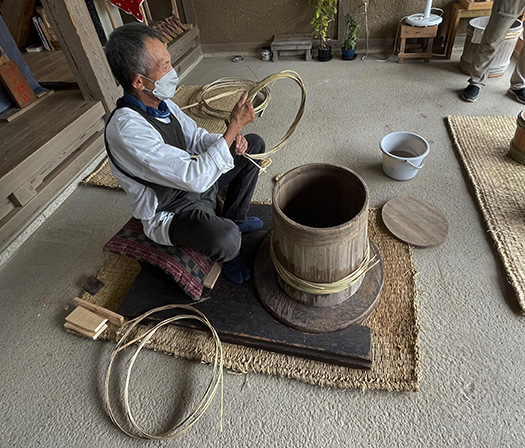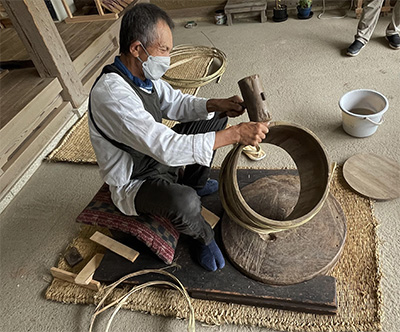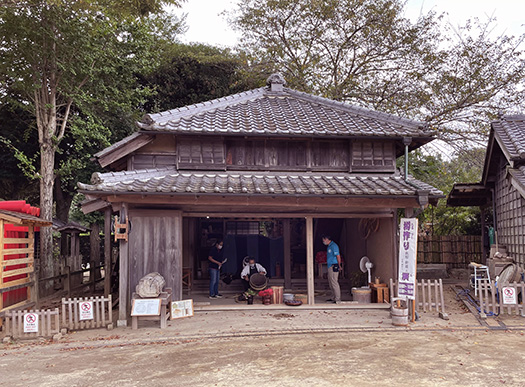

江戸期の千葉県、房総での商家の街並み「見える化」野外博物館探訪。
現代と江戸期のいちばん大きな違いは、現代では日本の基本的な「ものづくり」の実相を日常生活的にこどもたちが体感する機会が失せていること。江戸期までの社会ではどんなものづくりも基本的にその労働ぶりが公開される機会が多く提供されていた。こどもたちは現実の街中で具体的な職人仕事を見聞できていたので「ひとの仕事」についての豊かな想像力が刺激されていた。
写真は木工についての専門職の仕事ぶりが町場ですべて公開されていた様子の再現。「樽づくり」が行われていたけれど、樽の素材の木材の加工からそれを竹のリングで「締め上げていく」工程が衆人の見守る中で行われていた。具体的な手順がわかると同時に、真剣なものづくりへの「姿勢」も子どもたちは教えられることになっていた。一心不乱に作業に取り組む様子がこどもたちに仕事への「誇り」のようなものを感受させ植え付けていったことは想像に難くない。
そういうことが基盤となって、明治以降の急速な近代工業化社会の実現に大きく与っていたのではないか。ごく自然な「国民教育」の基盤を形成していたのではないかと考えられる。上の写真で言うと、部材の形状、その管理ぶり、そしてそれが手際よく組み上げられていく手順の合理性、段取り仕事の大切さなど教えられることは大きかったに違いない。職人にとっても自分の作業工程を包み隠さずに公開しているということは、正直に生きるということにも繋がっていたに相違ない。

個人的に面白く感じていたのは、長時間の労働であり「座って」の作業であるのに竹の輪での樽の締め上げ工程でも職人さんの「力の入れ方」がムリもムダもなく見えていたこと。で、職人さんが席を外したときにその座っている椅子を撮影してみた。そうしたら案の定、微妙に前傾姿勢を継続できるような角度が付けられていて、対面する樽に対して力の入れ具合にきわめて合理的なのだということに気付かされた。おそらくこの職人さんの体格的特徴に合わせて、微細な「工夫」が積層しているに違いなく、いわば段取りについての知恵を見る者にわかりやすく伝えてくれていた。

こういった「社会教育」が各職人仕事として「商家」という場で多くの人びとに公開され共有してきたことが、職人仕事への日本社会の強いリスペクトを生み出していたのだと感じさせられる。この房総のむらの現代でも参観に訪れていた多くの子どもたちが興味深そうにその仕事ぶりを見続けていた。
ひるがえって、今日の日本社会ではどうだろうか。どうもひとの手業での知恵と工夫の伝達が疎かになって、表面的な「点数稼ぎ」的な価値感が優勢になってしまってはいないだろうか。それは社会の活力にとってどうなのだろうかと、ふと疑問を感じさせられた。
English version⬇
Visible Manufacturing Industry “Woodworker-1” Bustling Bossou Townhouse, Edo Period – 2
Craftsmen’s work was open to the public in the town. It stimulated their own “devotion” and functioned as social education for the viewer. …
Visible” open-air museum visit to the streets of merchant houses in Boso, Chiba Prefecture, during the Edo period.
The biggest difference between today and the Edo period is that today, children no longer have the opportunity to experience the reality of basic Japanese “monozukuri” in their daily lives. Until the Edo period, any kind of craftsmanship basically provided many opportunities for the public to see how the work was done. Children were able to see and hear the work of craftsmen in the real world, which stimulated their rich imagination about “people’s work.
The photo shows a reproduction of a woodworking workshop where all the work of woodworking professionals was on display in the town hall. The “barrel making” was being performed, and the process of processing the wood for the barrels and “tightening” them up with bamboo rings was being carried out under the watchful eyes of the people. The children were able to understand the specific procedures and at the same time, were taught a serious “attitude” toward manufacturing. It is not difficult to imagine that the children’s single-minded devotion to their work instilled in them a sense of “pride” in their work.
This may have been the foundation that contributed greatly to the rapid realization of a modern industrialized society after the Meiji era. It is thought that this may have formed the basis for a very natural “national education. In the photo above, there must have been a great deal to be taught about the shapes of materials, how to manage them, the rationality of the procedures for assembling them in an efficient manner, the importance of work arrangements, etc. For craftspeople, too, there must have been a great deal to be taught about the importance of wrapping up their work processes. For the craftsmen, the fact that they were able to disclose their work processes without concealment must have been linked to their honesty in life.
What I personally found interesting was that even in the process of tightening up the barrels with bamboo rings, despite the long hours of labor and “sitting down,” I could see the craftsman’s “exertion” without any unreasonableness or waste. When the craftsman left his seat, I took a picture of the chair he was sitting on. Sure enough, the chair was slightly angled so that the craftsman could continue to lean forward, and I noticed that the angle was extremely reasonable in terms of the amount of force applied to the barrels he was facing. The craftsman’s fine “ingenuity” must have been layered according to his physique, and he was conveying his wisdom about the arrangements to the viewer in a way that was easy to understand.
The fact that this kind of “social education” was shared with many people in “merchant houses” as the work of various craftsmen made us feel that Japanese society had a strong respect for artisanal work. Even here in the present day village of Boso, many children who had come to observe the work of these craftsmen continued to watch with great interest.
What about today’s Japanese society? Hasn’t the transmission of wisdom and ingenuity through people’s handiwork been neglected, and a superficial “point-scoring” sense of value has prevailed? It made me wonder how this would be good for the vitality of society.
Posted on 1月 8th, 2023 by 三木 奎吾
Filed under: 日本社会・文化研究, 歴史探訪







コメントを投稿
「※誹謗中傷や、悪意のある書き込み、営利目的などのコメントを防ぐために、投稿された全てのコメントは一時的に保留されますのでご了承ください。」
You must be logged in to post a comment.